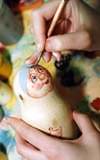| Home | Online Store | What is Milimili? | History Tours | Fairy Tales | About Us | Retail Stores | Order Info | Milimili Cards | Contact Us | Banner Exchange | |
| Doll History | Doll Magic | Doll Creating | Doll Opening |
| What is Milimili? |
| Milimili Doll is the name of the Island version of the Matryoshka as Russia continues to maintain it's presence as part of the cultural melting pot of the Hawaiian Islands. The word MILI in both Russian and Hawaiian translates as "beloved" and the Hawaiian word "MILIMILI" means a favorite "plaything" or "toy". MILIMILI is also used as a derivative of Mili'apa (slowing down or playing around). This name has become popular not only in Hawaii, but also in other States and countries, as people keep bringing Hawaiian Milimili Dolls from their vacation in Hawaiian Paradise. |
|
History of Matryoshka (Milimili) Doll |
 |
The Russian Matryoshka Doll (hand-painted wooden dolls nestled or fitting inside one another) is a symbol of Russian Folk Art and is a favorite of young and old alike. In the 19th century, Matryona was a common female name derived from the Latin root "mater" or mother. This is why traditionally the dolls were painted like women and every one is like a mother that has a baby inside. |
There are practically hundreds of villages where Matrioshka
dolls have been made for generations. There are a number of villages that are
known for their traditional designs. Here are some of them: Pereslavl, Maiden,
Kirov, Brest, Semionov.
Certainly Russian craftsman have been making Matryoshka Dolls for many hundreds
of years, at least back to the mid 1700s. These dolls carry a rich tradition
and will turn into family heirlooms.
In the year 1900 the Russian "Matreshka" was awarded a medal at the Paris Exhibition of Applied Arts. Since then this lovely and entertaining art form has continued to win awards (and hearts) world wide.
 |
Every set is hand-carved and hand-painted. Lime trees, known for its flowers from which honey with healing properties is obtained, are used to make Matryoshkas. The trees are cut in the early spring, stripped of their bark and dried in the open air for several years until the wood is ready. The logs are then cut and prepared for Matryoshkas. The whole set has to be made out of the same chunk of wood. That condition is a must and insures that every piece will react in the same fashion to changing temperature and climate conditions. Turning operations rely on intuition and great skill rather than exact measurements. After the hand-turning work is done, the dolls are cleaned, primed with starchy glue, polished and painted to depict a Russian image or story and set out to dry. After a few days, the dolls are given several coats of lacquer to give the dolls their brilliant shine. |
 |
Besides the traditional designs, the collectible Matrioshka dolls depict scenes from fairy tales, Russian churches an architecture of the cities and towns, life scenes of the people, political leaders, sports, animals, other arts. |  |
 |
Nesting dolls are made in many countries now, including India, Poland, Japan, and China, but the Russian matryoshkas are still the best known. Now they are depicted with many national designs. |  |
|
Take home a Milimili Doll for your favorite person to
play with!
|
|
Copyright © Universal
Artists, LLC, 2000-2001 - All rights reserved
|